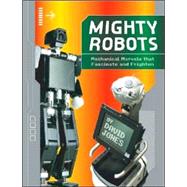
David Jones has written books, magazine articles, radio plays, and even scripts for interactive shows at NASA's Space Center in Houston. He lives in Vancouver.
| In Our Own Image | p. 2 |
| Where Are All the Robots? | p. 27 |
| Robot Explorers | p. 43 |
| Fighting Robots | p. 59 |
| Working Robots | p. 76 |
| Robots at Play | p. 92 |
| The Future | p. 106 |
| Index | p. 123 |
| Table of Contents provided by Ingram. All Rights Reserved. |
The New copy of this book will include any supplemental materials advertised. Please check the title of the book to determine if it should include any access cards, study guides, lab manuals, CDs, etc.
The Used, Rental and eBook copies of this book are not guaranteed to include any supplemental materials. Typically, only the book itself is included. This is true even if the title states it includes any access cards, study guides, lab manuals, CDs, etc.